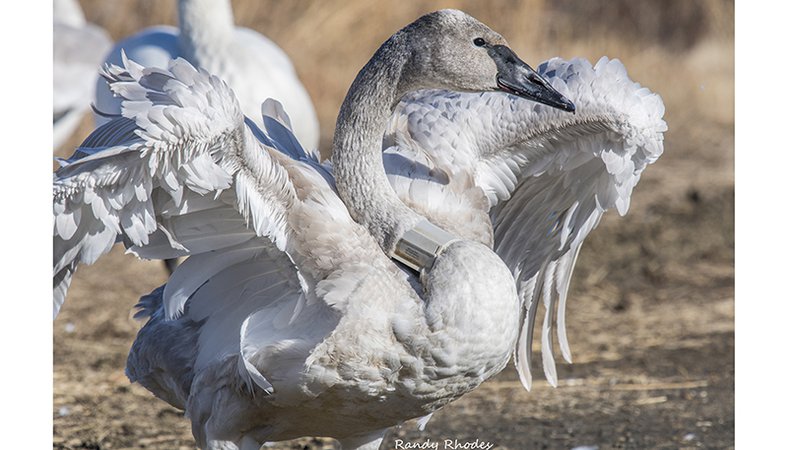Tracking trumpeter swan leads back to Iowa research group
ON 01-31-2018

Jan. 31, 2018
Randy Zellers
Assistant Chief of Communications
HEBER SPRINGS – Teamwork between wildlife photographers, birders and others around the country determined that a collared trumpeter swan spotted in Cleburne County recently was part of a tracking survey that began last summer in Iowa.
As Karen Rowe, the Arkansas Game and Fish Commission’s nongame migratory bird program coordinator, said, “It literally took a village to find out where this bird had originated.”
The search began innocently enough when Kenny Nations, an Arkansas wildlife photographer, sent Rowe a photograph of a trumpeter swan wintering at a pond in Cleburne County wearing an unusual-looking neck collar. Swans and geese are often banded by biologists with colored neck collars containing large alpha-numeric codes to identify them at a distance. However, this collar had no visible numbers or letters, nor was the collar the characteristic bright color of usual bands.
So Rowe sent Nations’ photo to several biologists around the country, including Margaret Smith, the executive director of The Trumpeter Swan Society, based in Plymouth, Minnesota. Smith admitted to Rowe that in the past, she would have been as puzzled as anyone by the unusual-looking color; however, last summer Smith had participated in the banding of nine juvenile trumpeter swans by the Iowa Department of Natural Resources and ornithology students at Iowa State University using different neck collars than ones employed in the past. These Global Positioning Satellite collars would allow the swans’ movements to be tracked by the Iowa researchers. Smith recognized the style of collar in the Arkansas photograph as the same as she had seen in Iowa.
From there, Smith forwarded the swan photo to Tyler Harms, with the Iowa Department of Natural Resources. While Harms confessed it was a long shot, he said the swan possibly could be identified if the very small numbers used on these collars could be viewed. Harms told Smith, who relayed to Rowe, that perhaps a birdwatcher could try to relocate the swan and use a spotting scope to read the tiny numbers on the collar.
The only problem, as Rowe said, was that there were over 500 swans wintering across Cleburne County. “Locating one specific swan wearing a tan collar somewhere on a pond, lake, river or field in this 592-square-mile county was the proverbial needle in the haystack,” Rowe said. So she asked both Nations and another avid bird and swan watcher, Terry Butler, to be on the lookout for a swan with a tan collar.
Butler was swan-watching at a pond belonging to Verlon Abrams, who is an avid trumpeter swan caretaker as well as the former commander of the Arkansas American Legion. Butler scanned the hundreds of swans on the pond before locating one with the tan collar, as well as a band. He could tell the collar had markings, though he couldn’t clearly make them out. But, it so happened that photographer Randy Rhodes happened to be nearby using an exceptionally long lens for his shots. Butler asked Rhodes if he could take detailed photos of the swan in question. Rhodes complied, getting detailed photos of the collar and leg band.
Rowe sent Rhode’s band and collar photos to the Iowa DNR. Turns out this swan was Cygnet 1702, a trumpeter swan originally banded in late summer 2017 at Otter Creek Marsh Wildlife Management Area in Tama County, Iowa. Reseachers had lost the transmitter signal in mid-September. The photos and Butler’s observations noted that the GPS transmitter was no longer attached to the collar, evidently lost somewhere on the swan’s migration. The Iowa DNR and Iowa State University students had no idea where in the flyway the swan was this winter, or if it was still alive.
A lot of timely coincidences fell into place to give the researchers some good news. As the TTSS’s Margaret Smith said, “A trumpeter swan’s identification and location was a case of lost and found, across the Mississippi Flyway, thanks to Arkansas birders.”
Recent News
Subscribe to Our Weekly Newsletter E-mails
Don’t miss another issue. Sign up now to receive the AGFC Wildlife Weekly Newsletter in your mailbox every Wednesday afternoon (Waterfowl Reports are published weekly during waterfowl season and periodically outside the season). Fishing Reports arrive on Thursdays. Fill in the following fields and hit submit. Thanks, and welcome!


